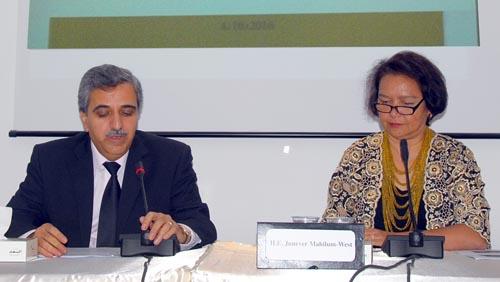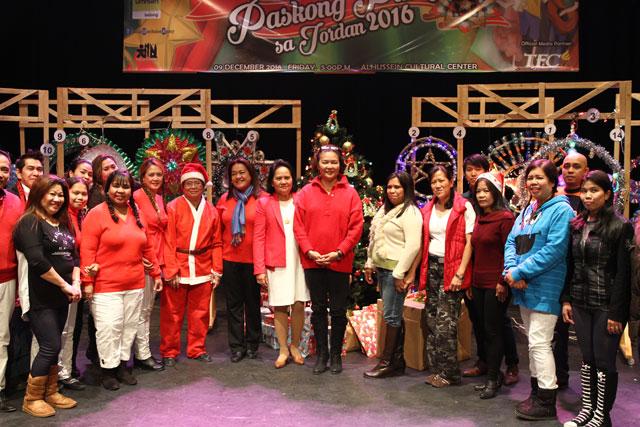You are here
Arab world’s ancient links to Philippines forged through trade, migration and Islam — ambassador
By Saeb Rawashdeh - Oct 11,2016 - Last updated at Oct 11,2016

Arab Thought Forum Secretary General Mohammad Abu Hammour introduces Philippine Ambassador to Jordan Junever M. Mahilum-West during a lecture in Amman recently (Photo courtesy of ATF)
AMMAN — Trade, migration and Islam have linked the Philippines and the Arab world since ancient times, according to Philippine Ambassador to Jordan Junever M. Mahilum-West.
During a recent lecture at the Arab Thought Forum, part of a series on the Arab world’s relations with other states, the ambassador said the region witnessed globalisation long before the age of European hegemony and colonialism, as economic migrants headed to Asia in search of better opportunities.
The first economic expansion began in the 9th century and lasted until the end of the 15th century, said the diplomat, explaining that Arab traders played a prominent role and used Southeast Asia for stopovers and trading posts.
“Top exports were mother-of-pearl shells, copra, fish and cordage, while top imports were cotton cloth, rice, yarn and thread, and opium,” Mahilum-West said.
During this period of intensive trade between the Arab world and Southeast Asia, the migration from the Hadramaut region (southern Yemen) occurred and, consequently, many Arabs settled in the Philippines, Ethiopia, Sudan, India, Brunei, Singapore, Malaysia, Indonesia, Thailand, Cambodia, southern Vietnam and China, she emphasised.
“In the case of the Philippines, the ancient Hadrami migration found its way from Islamised areas in the south towards Sulu, the southwestern archipelagic region of the Philippines,” she said, adding that the Hadramis settled in Cotabato, Maguindao, Zamboanga, Davao and Bukidnon.
An estimated 2 per cent of Filipinos can claim Arab ancestry, the ambassador noted.
“Today, Muslims comprise around 6 per cent of the Philippine population and Islam is a living religion and a cultural force, especially in Mindanao,” Mahilum-West highlighted.
Political and economic relations between the Philippines and the Arab world were boosted in 1970s during the time of oil shocks and political instability in the Philippines.
That decade “ushered the phenomenon of the deployment of Philippine labour to countries which urgently needed workers in the Middle East”.
The foreign policy of the Philippines became more diversified, taking in the new realities of “the three O’s”: oil, the Organisation of Islamic Cooperation and overseas Filipino workers, the ambassador said.
Saudi Arabia is the top supplier of crude oil to the Philippines, while Qatar is fourth, according to 2015 figures.
Meanwhile, out of a population of 110 million, 2.5 million Filipino workers live in the Middle East, including around 35,000 in Jordan, the diplomat noted.
“The Philippines ranks third highest in the world after India and the People’s Republic of China for remittances received from workers abroad,” she continued, “pegged at $2.9 billion, which represents 10 per cent of the Philippine GDP”.
“The presence of Filipino workers in the Middle East and other parts of the world has prompted the recasting of Philippine foreign policy,” stressed the ambassador.
The department of foreign affairs implements three pillars of the Philippine foreign policy: preservation and enhancement of national security; promotion and attainment of economic security; and protection of the rights and promotion of the welfare and interest of Filipinos overseas.
“Present-day globalisation, compared to early precursors of globalisation cited before, is occurring at much more rapid pace and grander scale, thanks to technology.
“ICT and its role in trade liberalisation and movement of people, goods, capital and services have made the whole world into one global interconnected economy,” Mahilum-West underscored.
In terms of future opportunities, the ambassador pointed to interfaith dialogue and harmony, South-South cooperation and trade and investment cooperation, among many others.
“This vastly more rapid pace of contemporary globalisation is presenting new opportunities and challenges,” she said.
Related Articles
AMMAN — Labour Minister Nidal Katamine on Thursday met with Philippine Ambassador to Jordan Junever M.
AMMAN — Bringing their local traditions with them to a home away from home, Filipinos in Jordan celebrated the Christmas season in a traditi
AMMAN — Public Security Department (PSD) Director Maj. Gen. Atef Saudi on Tuesday met with Filipino Ambassador to Jordan Junever M.















